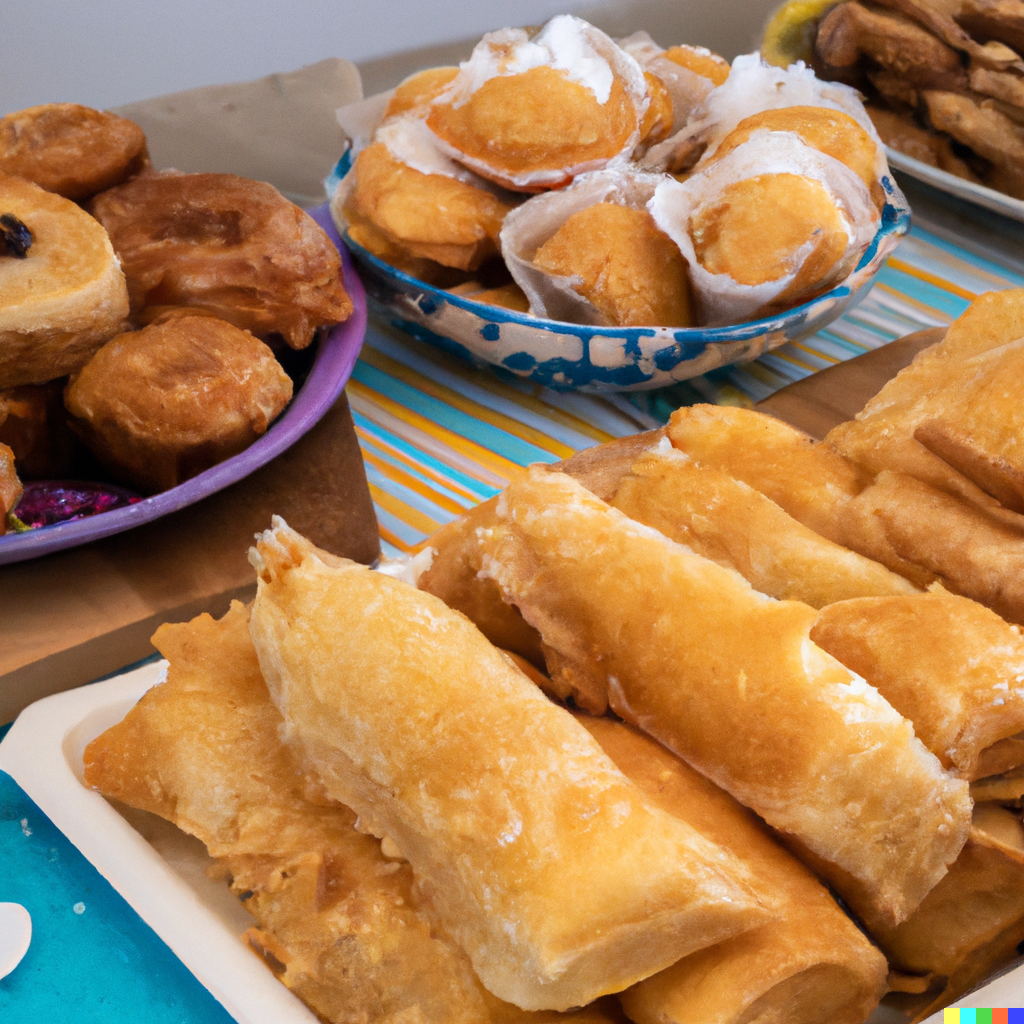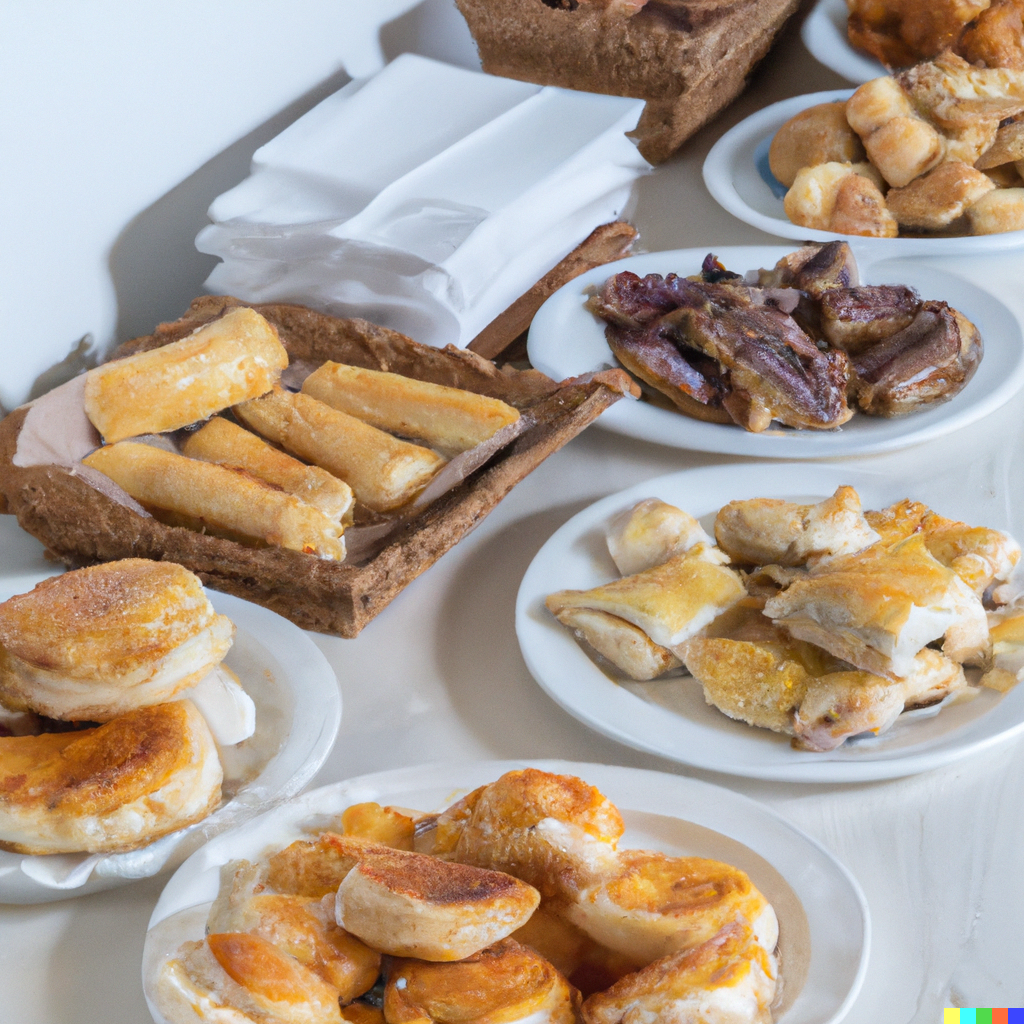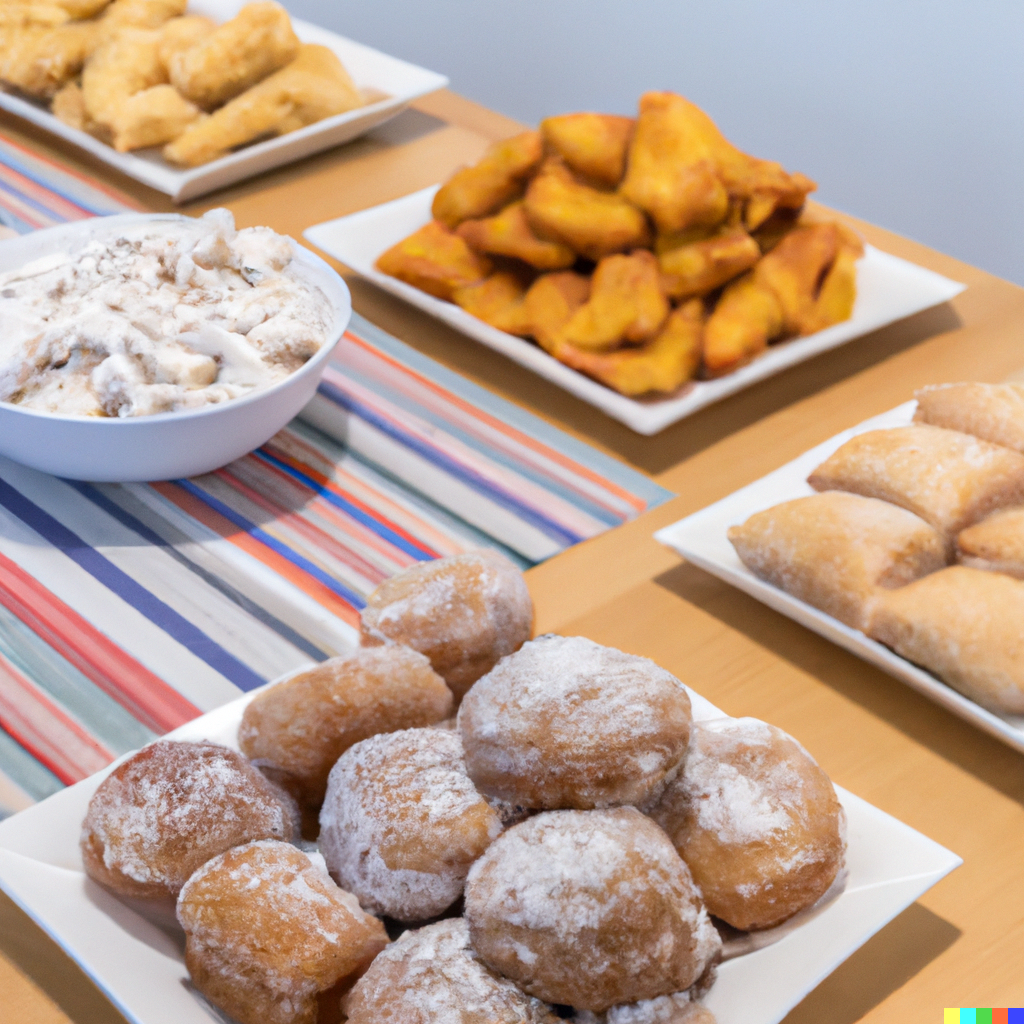Filipinos love their bread. So much so that in the Philippines, everywhere you go, chances are there’s a bakery just around the corner. From the local family baker in small villages called “barrios” to the big upscale malls scattered around the metropolitan area–bread is everywhere.
Known locally as “tinapay,” bread in the Philippines isn’t usually a staple in conventional meals except for breakfast. However, Filipinos usually have late afternoon snacks called “merienda,” a small pocket of respite from a hard day’s work as the afternoon transitions into night.
When it comes to Filipino bread, one bread, in particular, comes to mind, and that’s pan de sal or “salt bread.” Like many traditional Filipino dishes, pan de sal came from the early Spanish colonizers, when they introduced wheat and baking to the Philippines as natives were mainly just growing and consuming rice.
While Pan de sal is the most popular bread in the Philippines, it is just at the surface of what Filipino pastry offers. From twice-baked bread smeared with butter called “biscochos” borrowed from the Spanish to loaves of bread filled with sweet red bean paste courtesy of the Chinese. Filipino bread is as diverse as its people and rich cultural history.
5 of the Most Famous Filipino Pastries

These are 5 of the most popular Filipino pastries enjoyed all over the Philippines, with influences ranging from Spain and China. You’ll find these amazingly delicious pastries practically anywhere in the Philippines, and rightly so since nothing beats the convenience of bread for an average hard-working Filipino who’s always looking for something cheap, filling, and quick.
Pan de sal
As a nation tied to a vibrant food culture that evolved from trade and colonization, bread is as dynamic as any other traditional Filipino food. But one bread in particular practically remained the same; the Pan de sal.
Pan de sal or “salt bread” is an almond-shaped bread made from whole wheat flour, water, and salt, traditionally cooked in a “pugon” or wood-fired oven. It has a crusty texture similar to an English muffin, and its relatively neutral taste makes it the perfect bread for any filling or stuffing you can think of. Some Filipinos even dip it in a cup of coffee to soften it and give it some flavor.
A staple bread in bakeries around the Philippines, it’s highly doubtful that a local bakery does not serve Pan de sal, much less cook it themselves. Due to its popularity among Filipinos and being a breakfast staple, there’s a good chance it won’t be available if you try to buy some later in the day as it flies off these bakeries’ shelves relatively fast.
Many still practice cooking it in wood-fired ovens, especially in rural areas and remote villages in the Philippines. However, most Pan de sal Filipinos enjoy today are made using gas ovens. Mainly attributed to an oven’s ease of use and efficiency in baking them in bulks, maximizing profit in return.
Pan de coco
As a tropical country, coconut in the Philippines is very abundant. In fact, in a 2020 statistic on coconut production by leading country, the Philippines ranked 3rd in coconut production worldwide, producing 14.49 million metric tons of coconut, while India just edges it out in 2nd with 14.7 million metric tons.
Like many traditional foods, ingredients in a dish would naturally be the most readily available in the area. For the Philippines, it’s coconut, and the Pan de coco or “coconut bread” is a product of just that and indulges the sweet tooth of millions of Filipinos. Pan de coco is an incredibly delicious pastry, a roll of bread stuffed with sweetened grated coconut or “bukayo.”
Filipinos love sweet food, and the Pan de coco is a testament to that. As the name suggests, pan de coco has Spanish origins; however, Filipinos have modified it to their sweet palate by stuffing it with a sugary coconut paste. Usually bought in the morning when it is freshly baked and hot, it pairs excellently with coffee or hot chocolate; Its sweet coconut flavor and fluffy texture complement these hot beverages really well. A bakery in the Philippines also named “Pan de coco”, is known to serve pan de coco as their specialty product.
Pan de coco has also had a revamp in the pastry scene. There’s a bakery in Ortigas district in Manila called Arina Sweets Shop that serves pan de coco donuts as a specialty. They are made using a whole wheat milk bun, pan de coco filling, and doughnut glaze, which magically infuses the sweetness of a donut glaze and the light, yet delicious, notes from coconut.
Bibingka
No traditional Filipino pastry says Christmas like Bibingka. Usually sold by street vendors near churches during “simbang gabi,” a series of church services held early in the morning for nine days during the holiday season, Bibingka is remarkably filling and is served piping hot; preparing churchgoers for the day ahead.
Bibingka is a Filipino rice cake made with glutinous rice flour and coconut milk lined with banana leaves (similar to paper liners in muffins), which not only hold its shape but give it an extra depth of flavor. It is then cooked in terracotta ovens until brown, toasted at the top, and soft and chewy inside. Some vendors even top it with grated coconut for extra sweetness or salted egg for a savory twist.
In Filipino cuisine, Bibingka is classified as a “kakanin,” from the word “kanin,” which means rice as its main ingredient. Rice in Bibingkas makes it very filling and can even make you full and satiated with just one serving–which is perfect for a quick breakfast to start the day or as a sweet and tasty pick-me-up for an afternoon snack. Pair it with some coffee or hot chocolate, and you’re all set for a delicious and hearty meal.
Hopia
Aside from clear Spanish influences generally found in traditional Filipino cuisine, its incredibly diverse food culture can also be attributed to the Chinese. The Chinese’s influence birthed famous Filipino dishes such as “lumpia” (deep-fried spring rolls) and “pansit” (a savory Filipino noodle dish, similar to “Chow Mein”).
One dish, in particular, displays the Filipinos’ love for sweets. A bite-sized flaky pastry filled with sweetened red mung bean paste called Hopia, a Tagalog word derived from Hokkien “ho-bnia,” literally means “good biscuit.” Hopia arrived in the Philippines in the 1900s when peddlers used to sell it for 50 centavos or 1 peso per “bilao” (round hand-woven bamboo trays) as a delicious snack.
However, the Hopia’s rise in popularity is attributed to when a shop owner named Chua Chiu Hong, founder of Eng Bee Tin, a famous Filipino-Chinese Deli in the Philippines, invented the “Hopia ube.” It is Hopia filled with “Ube” or sweet purple yam instead of red mung beans. He got this idea after asking a local supermarket what their most popular ice cream flavor was.
Over the years, Hopia’s popularity only grew and eventually planted its roots in the ground of Filipino food culture. Since its inception, Hopia has evolved into multiple versions, from Durian-filled hopias to ground pork aptly named Hopiang baboy or “pork Hopia.”
Hopia is one of the most sought-after snacks for homesick Filipinos overseas, which some buy in bulk if they get a chance to visit the Philippines. Just one bite from a Hopia reminds them of the country they’ll always consider home–no matter where they are.
Ensaymada
The Ensaymada is famous for its appetizing appearance, buttered bread topped with sugar and grated cheese–incredibly soft, puffy, and sweet; Ensaymada is always a delight to eat. Ensaymadas are sold by small family bakeries and famous chain bakeries alike, but the taste and look of an Ensaymada are always unmistakable.
Ensaymada was introduced to the Philippines by the Spanish during colonial times, which used to bake it in pork fat or lard. Through the years, the Homemade Ensaymada slowly evolved and gained characteristics that made it authentically “Filipino,” like using butter instead of pork fat and adding sugar and grated cheese as toppings.
Ensaymadas can also take on new forms based on the region it is made. For instance, the Pampanga version of Ensaymadas is flaky. At the same time, the Ensaymadas from Bulacan are topped with ham or salted egg, giving it a complex combination of sweet and savory flavors.
During Christmas, Ensaymada topped with “queso de bola” or Edam cheese is paired with hot chocolate and traditionally enjoyed as a Christmas treat in “Noche Buena” or Christmas eve.
Filipinos, Pan de Sal, and Creativity

Creativity has always been essential to the evolution of dishes in Filipino cuisine. It is a crucial aspect in which Filipinos can turn foreign dishes authentically “Filipino.” Creativity is at the heart of it all, perhaps as a means to cut costs, due to the availability of ingredients, or to make food better suited to Filipino taste buds.
Filipino pastries are no exception, as it has been transforming in many ways since its first steps on Philippine shores up until today. It is well known that most Filipino pastries were borrowed and transformed into what they are today. However, these revamped pastries are undergoing their own evolution today.
One good example is the humble Pan de sal, a seemingly plain bread generally used for everything. Pan de sal is there and ready to inspire creativity, from simply filling it with cheese to using it as the main ingredient in foreign pastry dishes such as Eggs benedict in upscale Filipino fusion restaurants.
Due to its neutral taste, Pan de sal was subject to much experimentation, but nothing was as famous as the “Ube cheese Pan de sal,” which was Pan de sal stuffed with “Ube,” a purple yam, similar to sweet potatoes, and cheese. And Filipinos love their Ube. They make it into anything from jams, pastes, cakes, and even ice cream.
Ube cheese pan de sal is just one among the many potential versions that a Pan de sal can be made. Another famous version of Pan de sal is made with Malunggay or “Moringa,” a leafy vegetable recognized for its health benefits like antioxidants and vitamins. For people concerned with health and how to incorporate vegetables into their diet, Malunggay Pan de sal is a great way to start.
Other Amazing Filipino Pastries

As an archipelago, many people in the Philippines were relatively isolated for many years in islands, each with its own diverse cultures, language, and of course, food. Aside from the 5 famous pastries, these various cultures ultimately made their own kinds of different pastries that are still enjoyed today. While wildly different, these pastries are still true blue Filipino.
- Biscocho - Borrowed from the Italian Biscotti, Biscocho is a native delicacy from Ilo-ilo, a southern region of the Philippines. It is twice-baked bread with a crispy texture, coated in butter and sugar, giving it a pleasant aroma.
- Pastel - Don’t let the name fool you; unfortunately, you only get this sweet and yummy pastry super soft in one color. Pastels are cupcake-shaped pastries from the Camiguin island province filled with “Yema,” a creamy and custard-like many filipinos confection made with egg yolks, condensed milk, and eggs. Pastel is Spanish for “cake.”
- Lechon bread - Lechon is a general term used in the Philippines for pit-roasted whole pigs. Lechon bread is, funnily enough, just Lechon-shaped bread from Antipolo. It is incredibly trendy during Christmas when some families can’t afford Lechon in their “Noche Buena,” While real Lechon is delicious, one can argue that Lechon is but a symbol of abundance and festivity; which the Lechon bread exhibits.
- Napoleones - The Filipino take on the French Mille-Feuille, hailing Negros Occidental, considered the sugar capital of the Philippines. This sweet bread rectangular-shaped pastry is filled with custard creme and glazed with powdered sugar. It is incredibly flaky and delicious with a “melts in your mouth” kind of feel.
- Panyalam - It is a traditional fried rice pancake from the most southern central island in the Philippines, Mindanao. Similar to Bibingka, it is made with glutinous rice flour and coconut milk. However, the similarities end there, as Panyalam uses “muscovado sugar,” a type of unrefined sugar that retained its molasses component.
- Pinagong - It is a dense yet sweet, soft, and creamy turtle-shaped bread for special occasions from the Quezon province. Its name, Pinagong, comes from the word “pagong” in Tagalog, meaning “turtle,” which it gets from its turtle-shaped exterior that becomes a bit hard after baking it.
Conclusion
Through its hardships, the Filipino’s resourcefulness, and creativity sparked terrific contributions to its food culture, especially when it comes to its pastries. While Filipinos are by no means the pioneers of bread worldwide, they have made created unique and delicious pastries they can confidently call their own.
We can learn a thing or two from the Filipino Pan de sal, as we too have the potential to change and become extra special and evolve into amazing Ube cheese Pan de sals in our own way. All we need to do is find that spark of creativity.
Frequently Asked Questions (FAQs)
How long does ensaymada last in the fridge?
It will usually last for about five days in the fridge. However, it's best to check the expiration date to be sure. Make sure to use parchment paper or plastic wrap for perfect protection.
Ensaymada is a type of Filipino bread that is usually made with cheese and eggs. It's a popular breakfast food, but it can also be eaten as a snack or dessert. Ensaymada can be stored in the fridge for up to five days, but it's best to check the expiration date to be sure.
What are the types of ensaymada?
There are four main types of ensaymada not counting the recipes: moot, de broma, coffee and chocolate. Moot is the simplest form of ensaymada, made with just flour, water and salt. De broma refers to an ensaymada filled with a sweet filling like chocolate or jam. Coffee ensaymadas are moistened with coffee before being rolled in sugar. Chocolate ensaymadas are made with chocolate instead of flour.
Do you eat ensaymada hot or cold?
There's no right answer to this question - it's all about personal preference! Some people prefer to eat their best homemade ensaymada hot, while others enjoy it cold. There's no correct way to enjoy this delicious Filipino pastry, so eat it however you like!
If you're wondering, I personally prefer to eat my ensaymada cold. I find that the flavors seem to pop more when the pastry is slightly chilled, and I really enjoy the slightly chewy texture of the bread when it's not piping hot. But again, there's no wrong way to do it - Eat whatever makes you happy!
What kitchen utensils are needed to bake Filipino pastry?
To make Filipino pastry, you'll need a few common kitchen utensils for all baked goods, including a mixing bowl, measuring cups and spoons, wax paper, a spoon or spatula for stirring, and an oven. You may also find it helpful to have a mixer or handheld blender or stand mixer at medium speed to help mix the dough.
Filipino pastry is typically made with more flour, sugar, butter, eggs, and baking powder. You can either use a recipe to make the dough or most Filipinos buy pre-made dough from your local bakery. Be sure to follow the baking instructions carefully so that your pastry comes out crispy and golden brown store them in a warm place. Enjoy!
What is the best Filipino bread melted butter grated cheese?
There's no definitive answer, as everyone has their own personal preference. But some of the more popular options include pandesal, ensaymada, and Calmar.
As for the best way to melt the butter and grate the cheese, that's also up to you. Some people prefer using a microwave or stovetop, while others might use an oven or toaster oven. Experiment until you find what works best for you.

